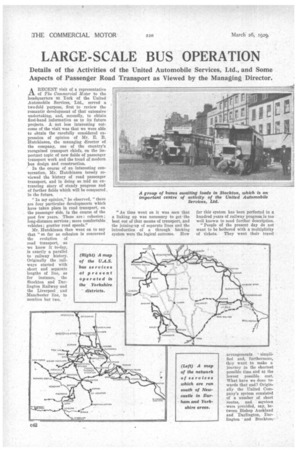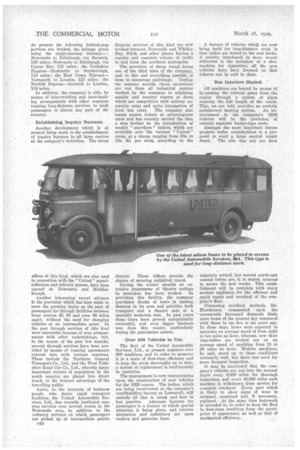LARGE-SCALE BUS OPERATION
Page 72

Page 73

Page 74

If you've noticed an error in this article please click here to report it so we can fix it.
Details of the Activities of the United Automobile Services, Ltd., and Some Aspects of Passenger Road Transport as Viewed by the Managing Director.
ARECENT visit of a representative of The Commercial Motor to the headquarters at York of the United
Automobile Services, Ltd., served a two-fold purpose, first to review the romantic development of that extensive undertaking, and, secondly, to obtain first-hand information as to its future projects. A not less interesting out come of the visit was that we were able to obtain the carefully considered ex pression of opinion of Mr. E. B.
Hutchinson, the managing director of the company, one of the country's recognized transport chiefs, on the important topic of new fields of passenger transport work and the trend of modern bus design and construction.
In the course of an interesting conversation. Mr. Hutchinson tersely re viewed the history of road passenger transport, and in doing so told an entrancing story of steady progress and of further fields which will be conquered , in the future.
"In my opinion," he observed, " there are four particular developments which have taken place in road transport, on the passenger side, in the course of the past few years. These are: cohesion ; long-distance services; more comfortable vehicles ; greater road speeds."
Mr. Hutchinson then went on to say that "so far as cohesion is concerned the evolution of road transport, as we know it to-day,
is exactly a parallel
to railway history. Originally the rail ways started with short and separate lengths of line, as for instance, the Stockton and Darlington Railway and the Liverpool and Manchester line, to mention but two.
"As time went on it was seen that a linking up was necessary to get-the best out of that means of transport, and the joining-up of separate lines and the introduction of a through booking system were the logical outcome. How
far this system has been perfected in a hundred years of railway progress is too well known to need further description.
"People of the present day do not want to be bothered with a multiplicity of tickets. They want their travel
and Stockton and West Hartlepool. From time to time a new link was added to the chain of routes.
"Bus cohesion takes effect iii this manner. The company has now linked up routes of the kind I have mentioned by means of inter-connecting time-tables and the issue of through tickets over two, three and even four sections. The big advantage to the travelling public is that it is assured of a connecting vehicle—with no waiting in a cold market place—it is not troubled with a number of tickets, and-saves money on the through journey because through tickets are issued at a price which shows a material reduction compared with the making of the journey sectionally. Railway history is repeating itself exactly."
"To carry the comparison a stage farther," queried our representative, "do you see any future for 'main line' express bus services between the more important centres, working in conjunction with short-journey routes for purely loeal traffic? "
"Most certainly," was Mr. Hutehin
Son's reply. "Trunk-line services are essential, so much so that we have maintained all-winter long-distance services which we inaugurated last year The public finds that buses built specially for long-distance work are well lighted and well heated and, generally, provide every reasonable comfort and convenience, and for these reasons they are being used to an increasing extent. There is no doubt that the modern motorbus body is becoming more luxurious. The public is not satisfied with the ill-ventilated, badly heated and poorly lighted vehicle of a few years ago. What it wants is something approaching first-class railway facilities at something under thirdclass fares, and I can safely say that, so far as we are concerned, we are giving it.".
An unusual line of thought was opened up by Mr. Hutchinson in his reference to modern bus design.
In his opinion, north-country .people are more discerning and more insistent upon luxury travel facilities than the southerner.
Whilst visualizing a big future for day-time long-distance passenger road transport, Mr. Hutchinson does not see any useful field of activity for night sleeper services. As might be expected, the United Automobile Services, Ltd., has kept a close watch upon the sleepercoach developments. Besides envisaging a limited patronage for this class of service, the company sees big drawbacks to the successful working of night services. This is, of course, purely an expression of opinion, but coming from an important undertaking due weight must be given to it.
On this topic Mr. Hutchinson observed, "My information is that gearchanging on night-sleeper vehicles is such as to prevent continuous and restful sleep. Again, there is little privacy, and I feel that the night-sleeper bus cannot even be compared with the new third-class railway sleepers."
Now to turn from the general aspect to matters more directly connected with the United Automobile Services, Ltd. This undertaking's growth is one of the romances of the road-transport industry, and is too well knowe to warrant a detailed description. Suffice it to say that in 1912 the company started in a very modest way with obe or two services in Norfolk and County Durham. Now from centrally situated headquarters at York there is managed a tremendous network of services representing a total mileage of 1,700. Last year the company carried over 60,000,000 passengers, or over 1,000,000 passengers per week. The districts worked are as follow :—Northumberland, Cleveland, County Durham and Yorkshire, Norfolk, South Lincolnshire.
During the past year over 200 entirely up-to-date, well-appointed £E4J. saloon buses were obtained for fleet replacements and to make provision for longdistance travel. At present the following limtted-stop services are worked, the mileage given being the single-journey distance :— Newcastle to Edinburgh, via Berwick, 120 miles ; Newcastle to Edinburgh, via Carter Bar, 112 miles ; the Yorkshire Express—Newcastle to Scarborough, 110 miles; the East Coast Express— Yarmouth to London, 123 miles ; the Norfolk Express—Norwich to London. 134 miles.
In addition, the company is able, by means of inter-working and inter-booking arrangements with other concerns running long-distance services, to book passengers to almost any part of the country.
Esiablishing Inquiry Bureaux.
Another development which is at present being made is the establishment of inquiry bureaux in all large centres of the company's activities. The latest offices of this kind, which are also used in connection with the "United" parcelcollection and delivery system, have been opened at Newcastle and Middlesbrough.
Another interesting recent advance is the provision which has been made to meet the growing desire on the part of passengers for through facilities between large centres 40, 50 and even 60 miles apart, without the need for changing vehicles at an intermediate point. In the past through services of this kind were impossible because of area arrangements with other undertakings, but, in the course of the past few months, several through services have been provided by means of running agreements entered into with various concerns. These include the Northern General Transport Co., Ltd., and the 'West Yorkshire Road Car Co., Ltd., whereby many important centres of population in the north country are placed into direct touch, to the distinct advantage of the travelling public.
Again, in the interests of business people who desire rapid transport facilities, the United Automobile Services, Ltd., has recently instituted nonstop serviees over several routes in the Newcastle area, in addition to the ordinary services on which passengers are picked up at intermediate points.
c44 Express services of this kind are now worked between Newcastle and 'Whitley Bay, Illyth and other places having a regular and constant volume of traffic to and from the northern metropolis.
The provision of cheap travel forms one of the chief aims of the company, and to this end everything possible is done to encourage patronage. During the summer months cheap excursions are run from all industrial centres worked, by the company to adjoining seaside and country resorts at fares which are competitive with railway excursion rates and quite irrespective of local bus rates. • The company also issues season tickets at advantageous rates and has recently carried the idea a step farther by the introduction of weekly " anywhere " tickets, which are available over the various "United" areas, at a charge ranging from 10s. to 12s. 6d. per week, according to the
district. These tickets provide the chance of securing unlimited travel.
During the winter months an extensive programme of theatre outings by motorbus has been worked. In providing this facility, the company purchases blocks of seats in leading theatres in its area and provides both transport and a theatre seat at a specially moderate rate. In past years these tours have proved exceptionally successful, and even bigger business was done this winter, particularly during the pantomime season.
Over 600 Vehicles in Use.
The fleet of the United Automobile Services, Ltd., at present numbers over 600 machines, and in order to preserve it in a state of first-class efficiency and to keep the stock thoroughly up to date, a system of replacement is continuously in operation.
The management is now concentrating upon the construction of new vehicles for the 1929 season. The bodies, which are being constructed at the company's coachbuilding factory at Lowestoft, will embody all that is latest and best in bus practice. Adequate legroom for passengers is a feature to which special attention is being given, and interior decoration and upholstery are upon modern and generous lines.
A feature of vehicles which arc now being built for long-distance work is that tables are bolted to the seat backs. A novelty introduced in more recent deliveries is the inclusion of a slotmachine for cigarettes; all the new vehicles have been licensed so that tobacco can be sold in them.
Bus Interiors Heated.
All machines are heated by means of by-passing the exhaust gases from the engine through a system of pipes running the full length of the coach. This, we are told, provides an entirely
satisfactory heating system. An improvement in the company's 1929 vehicles will be the provision of entirely separate bucket-type seats.
Amongst the most important future projects Tinder consideration is a proposal to erect a large central repair depot. The site has not yet been definitely settled, but several north-east coastal towns are, it is stated, anxious to secure the new works. This establishment will be complete with every modern appliance for the efficient and rapid repair and overhaul of the company's fleet.
Discussing overhaul methods, Mr. Hutchinson commented upon the enormously increased demands niade upon buses of the present day compared with those in use five or six years ago. In those days, buses were expected to maintain an average speed of from eight to ten miles an hour, whereas, now their time-tables are worked out on an average speed of anything from 15 to 20 miles an hour. Modern machines, he said, stood up to these conditions extremely well, but there was need for more frequent inspection.
It may be mentioned that the company's vehicles are run into the nearest depot every 6,000 miles for thorough Inspection, and every 40,000 miles each machine is withdrawn from service for complete overhaul. Every part which is likely to show signs of wear is stripped, examined and, if necessary, replaced. At the same time bodywork is attended to, in order to keep the fleet in first-class condition from the standpoint of appearance, as well as that of mechanical efficiency.




























































































































